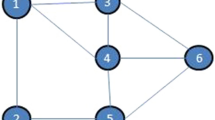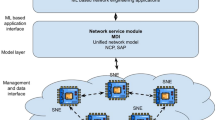Abstract
The optical access networks (OANs) provide an attractive solution to the bandwidth bottleneck problem of the last mile. However, it has been proved (Baliga et al. in J Lightwave Technol 27(13):2391–2403, 2009; Baliga et al. in IEEE Commun Mag 49(6):70–77, 2011) that the OAN consumes a significant ratio of the total energy consumed in an optical networking scenario. This has provided incentive for inspection of energy-efficient schemes for OANs. It has been demonstrated in the literature that energy consumption figures of an OAN can be improved by either designing efficient hardware or employing better media access control (MAC) protocols. In this paper, we design a MAC protocol for OANs to ensure energy-efficiency in the presence of quality of service (QoS)-aware traffic. The proposed scheme incorporates traffic prediction-based selection of different sleep (energy-efficient) modes of operation, of the optical network units—ONUs (OAN end units). It also implements switching between different sleep modes to maintain high QoS with significant energy-efficiency figures. The discussed scheme requires processing at the ONU only and can work independent of the entire OAN (ONU assisted). Thus, our proposal is an attractive solution for the already deployed networks or even in green field deployment.
















Similar content being viewed by others
References
Baliga, J., Ayre, R., Hinton, K., Sorin, W.V., Tucker, R.S.: Energy consumption in optical IP networks. J. Lightwave Technol. 27(13), 2391–2403 (2009)
Baliga, J., Ayre, R., Hinton, K., Tucker, R.S.: Energy consumption in wired and wireless access networks. IEEE Commun. Mag. 49(6), 70–77 (2011)
IEEE Standard for Information Technology—Local and Metropolitan Area Networks—Part 3: CSMA/CD Access Method and Physical Layer Specifications Amendment: Media Access Control Parameters, Physical Layers, and Management Parameters for Subscriber Access Networks. IEEE Std 802.3ah-2004, pp. 1–640 (Sept 2004)
Skubic, B., Hood, D.: Evaluation of onu power saving modes for gigabit-capable passive optical networks. IEEE Netw. 25(2), 20–24 (2011)
Hosseinabadi, M.T., Ansari, N.: Multi-power-level energy saving management for passive optical networks. IEEE/OSA J. Opt. Commun. Netw. 6(11), 965–973 (2014)
Herreria-Alonso, S., Rodriguez-Perez, M., Fernández-Veiga, M., Lopez-Garcia, C.: On the use of the doze mode to reduce power consumption in epon systems. J. Lightwave Technol. 32(2), 285–292 (2013)
Dixit, A., Lannoo, B., Colle, D., Pickavet, M., Demeester, P.: Energy efficient dynamic bandwidth allocation for ethernet passive optical networks: overview, challenges, and solutions. Opt. Switch. Netw. 18, 169–179 (2015)
Bhar, C., Chatur, N., Mukhopadhyay, A., Das, G., Datta, D.: Designing a green optical network unit using ARMA-based traffic prediction. In: 2015 IEEE International Conference on Advanced Networks and Telecommunications Systems (ANTS), pp. 1–6. IEEE (2015)
Wong, S.-W., Valcarenghi, L., Yen, S.-H., Campelo, D.R., Yamashita, S., Kazovsky, L.: Sleep mode for energy saving PONs: advantages and drawbacks. In: GLOBECOM Workshops, 2009 IEEE, pp. 1–6. IEEE (2009)
Dias, M.P.I., Karunaratne, B.S., Wong, E.: Bayesian estimation and prediction-based dynamic bandwidth allocation algorithm for sleep/doze-mode passive optical networks. J. Lightwave Technol. 32(14), 2560–2568 (2014)
Dixit, A., Lannoo, B., Colle, D., Pickavet, M., Demeester, P.: Onu power saving modes in next generation optical access networks: progress, efficiency and challenges. Opt. Express 20(26), B52–B63 (2012)
Khotimsky, D.A., Zhang, D., Yuan, L., Hirafuji, R.O., Campelo, D.R.: Unifying sleep and doze modes for energy-efficient PON systems. IEEE Commun. Lett. 18(4), 688–691 (2014)
Dias, M., Wong, E.: Performance evaluation of VCSEL ONU using energy-efficient just-in-time dynamic bandwidth allocation algorithm. In: Photonics Global Conference (PGC), 2012, pp. 1–5. IEEE (2012)
Wang, F., Li, D., Zhao, Y.: Prediction of self-similar traffic and its application in network bandwidth allocation. In: International Conference on Wireless Communications, Networking and Mobile Computing, 2007. WiCom 2007, pp. 1980–1983. IEEE (2007)
ARIMA Models for Time Series Forecasting. http://people.duke.edu/~rnau/411arim.htm
Kramer, G., Mukherjee, B., Pesavento, G.: Ipact a dynamic protocol for an ethernet PON (EPON). IEEE Commun. Mag. 40(2), 74–80 (2002)
Mostowfi, M.: A simulation study of energy-efficient ethernet with two modes of low-power operation. IEEE Commun. Lett. 19(10), 1702–1705 (2015)
Author information
Authors and Affiliations
Corresponding author
Rights and permissions
About this article
Cite this article
Bhar, C., Chatur, N., Mukhopadhyay, A. et al. Designing a green optical network unit using ARMA-based traffic prediction for quality of service-aware traffic. Photon Netw Commun 32, 407–421 (2016). https://doi.org/10.1007/s11107-016-0671-y
Received:
Accepted:
Published:
Issue Date:
DOI: https://doi.org/10.1007/s11107-016-0671-y




